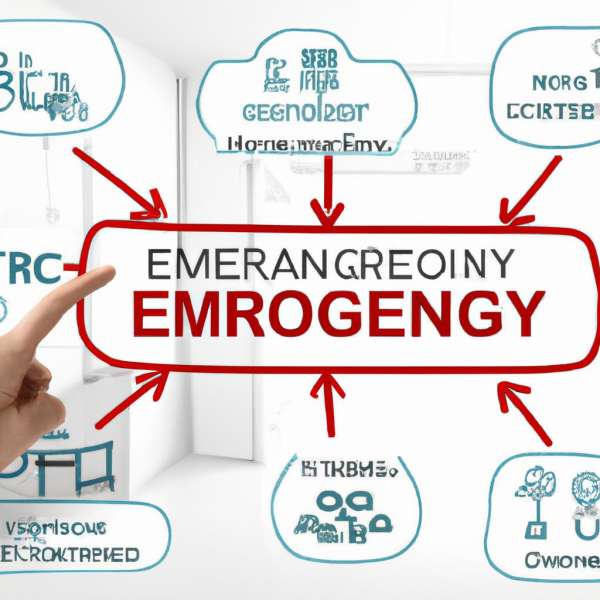Title: Understanding the Complexities of Emergency Room Malpractice Claims
Emergency rooms are the frontline of urgent medical care, providing critical services to those in immediate need. However, the high-pressure environment can sometimes lead to errors, raising concerns about emergency room malpractice claims. When patients experience the consequences of medical mistakes in such a fast-paced setting, the journey ahead can seem overwhelming and uncertain. This article delves into the intricacies of emergency room malpractice, examining the legal framework, the responsibilities of medical professionals, and the essential steps patients can take to advocate for themselves. Whether you are a patient seeking clarity or a healthcare provider aiming to understand the implications of your practice, this guide aims to provide valuable insights and empower those facing this challenging situation.

Key Concepts and Common Scenarios in Emergency Room Malpractice
Emergency rooms are often hectic environments where swift decisions are crucial for patient outcomes. However, the urgency of these settings can sometimes result in errors that may constitute malpractice. Understanding the key concepts of emergency room malpractice is vital for patients and families navigating this complex area of healthcare. Important concepts include the standard of care, duty of care, and breaches in these duties. Often, determining malpractice depends on whether a medical professional acted with the reasonable skill and care expected in similar circumstances.
Common scenarios that may lead to malpractice claims in the emergency room include:
- Misdiagnosis or Delayed Diagnosis: Failing to accurately diagnose conditions such as heart attacks or strokes promptly can have severe consequences.
- Medication Errors: Administering the wrong medication or incorrect dosages is another prevalent issue that can significantly impact patient safety.
- Improper Treatment: Providing substandard care, such as failing to follow established protocols or neglecting critical tests.
- Inadequate Patient Monitoring: Not closely monitoring a patient’s vital signs can lead to missed signs of deterioration.
To effectively navigate a potential malpractice situation, understanding the specific elements involved can streamline the process. Consider the following aspects:
| Element | Description |
|---|---|
| Duty of Care | Healthcare providers must deliver care that meets established medical standards. |
| Breach of Duty | An act or omission that falls below the expected standard of care. |
| Injury | Actual harm or injury must occur as a direct result of the breach. |
| Causation | Establishing a direct link between the breach of duty and the injury suffered. |
By familiarizing oneself with these critical components, individuals can better understand the nature of their claims and seek appropriate justice or compensation. Engaging with legal professionals experienced in medical malpractice can further assist in navigating the often-overwhelming landscape of healthcare disputes.

Steps to Take After an Incident: Navigating the Legal System
When dealing with the aftermath of an incident that may involve emergency room malpractice, it’s crucial to approach the situation with clarity and composure. Start by documenting everything related to the event. Create a detailed account that includes:
- Dates and Times: Record the exact date and time of your visit to the emergency room.
- Medical Records: Obtain copies of all medical records related to the treatment received.
- Witnesses: Identify any individuals who may have witnessed the incident or your treatment.
- Symptoms and Outcomes: Document specific symptoms, your condition before and after treatment, and any complications that arose.
Once documentation is in place, it’s advisable to seek legal counsel experienced in medical malpractice claims. An attorney can help evaluate the merits of your case, clarify your rights, and discuss potential next steps. Be prepared to share your records and account, as this information will be vital for building your case.
Another crucial step is to understand the legal timeline in your jurisdiction. Many states have statutes of limitations that dictate how long you have to file a claim. Understanding these timelines is essential to ensure your case is heard.
you need to file a claim. Here are some key timeline elements to consider:
| Action | Timeframe |
|---|---|
| Initial Consultation with an Attorney | Within 30 days of the incident |
| Filing a Malpractice Claim | Varies by state, typically 1-3 years |
| Gathering Evidence | Ongoing until filing |
| Settlement Negotiations | Post-filing, varies greatly |
Stay proactive about your health. Continue to seek medical care for any ongoing issues resulting from the incident, and keep detailed records of all treatments and their effects. This not only aids in your recovery but also strengthens your case if legal action becomes necessary.

Collecting Evidence: Crucial Documentation and Witness Statements
When pursuing a malpractice claim related to an emergency room incident, gathering strong evidence is essential to support your case. The documentation you compile will form the foundation of your claim. Begin with key medical records, such as:
- Admission records – Document the initial evaluation and complaints.
- Treatment notes – Record the care provided and any deviations from standard practices.
- Laboratory results – Include blood tests, scans, and other relevant diagnostics.
- Discharge summary – Detail the final assessment and instructions given to the patient.
In addition to medical documentation, witness statements can significantly strengthen your case. These may include statements from individuals who were present during the incident, such as family members or friends. Be sure to gather written statements or affidavits that include:
- Detailed observations – What was seen and heard during the emergency room visit.
- Timeline of events – Establish a clear sequence of actions and responses provided by medical personnel.
Consider creating a table to categorize your evidence effectively:
| Type of Evidence | Description | Source |
|---|---|---|
| Medical Records | Comprehensive documentation of patient treatment and care | Hospital records department |
| Witness Statements | Affidavits from bystanders or family members | Personal accounts |
| Expert Testimony | Statements from medical professionals in the field | Consultations with specialists |
Having all this evidence organized can be instrumental in making your case more compelling. Whether you approach settlement negotiations or pursue litigation, a thorough compilation of supporting materials not only validates your claims but also helps in establishing the credibility of your case.

Seeking Legal Expertise: Selecting the Best Attorney for Your Case
When dealing with the complexities of an emergency room malpractice claim, choosing the right attorney is crucial. Not all legal professionals have the same level of expertise or experience in medical malpractice cases, so it’s important to be thorough in your selection process. Here are some key factors to consider:
- Experience in Medical Malpractice: Look for an attorney who specifically specializes in medical malpractice, particularly in emergency room cases. Their familiarity with medical standards and legal precedents can significantly impact your case’s outcome.
- Track Record:Review Their Track Record: Investigate the attorney’s history with similar cases. An attorney with a proven track record in handling emergency room malpractice claims will likely have a deeper understanding of the complexities involved.
- Effective Communication: It’s crucial that the attorney can explain intricate medical and legal details clearly. Assess their ability to simplify complex concepts and keep you informed about your case’s progress.
- Initial Meeting: Many attorneys provide free initial consultations. Use this time to gauge their approach. Are they attentive to your narrative? Do they show genuine interest in your case?
Additionally, evaluate the attorney’s professional standing through online reviews, legal directories, and recommendations from other professionals. A well-regarded attorney can often streamline the claims process and potentially increase your chances of obtaining fair compensation. It’s also beneficial to ask about the attorney’s network, including medical experts who can offer valuable insights into your case.
| Criteria | Significance |
|---|---|
| Expertise in Medical Malpractice | High |
| Years of Practice | Medium |
| Successful Case Results | High |
| Client Interaction | Medium |
| Reputation and Reviews | High |
The competence and integrity of your legal representation can significantly impact your journey through the complex legal terrain of emergency room malpractice. Ensure you conduct comprehensive research and consult multiple attorneys before making your decision. Your case merits the best possible advocacy.
Final Thoughts
In the healthcare sector, unexpected events can lead to challenging situations, especially in emergency room settings. As discussed, navigating the intricate world of malpractice claims requires a combination of knowledge, strategy, and emotional strength. Remember, you are not alone in this process; legal resources and support systems are available to help you manage your case’s complexities. As you move forward, emphasize thorough documentation, timely actions, and seeking professional guidance. By equipping yourself with information and understanding your rights, you can effectively advocate for yourself or your loved ones. Here’s to hope and healing, both in the emergency room and in the quest for justice.

Navigating the Storm: Your Guide to Handling Emergency Room Malpractice Claims
Understanding Emergency Room Malpractice
Emergency room malpractice can occur when a healthcare professional fails to provide the proper standard of care in an emergency setting. This can lead to severe injuries or even death. Recognizing the warning signs early on can be a critical first step in taking appropriate action.
Recognizing Medical Malpractice in the ER
- Misdiagnosis or delayed diagnosis
- Surgical errors
- Medication errors
- Failure to order necessary tests
- Improper discharge
Case Studies: Real-Life Experiences
Here are some real-world examples where emergency room malpractice led to legal claims:
| Case | Outcome |
|---|---|
| Misdiagnosed Heart Attack | Settlement of $2 million for delayed treatment |
| Medication Overdose | $1.5 million awarded due to improper dosage |
| Surgical Error | $3 million awarded for permanent injury |
Benefits of Seeking Legal Advice
Engaging with a knowledgeable medical malpractice attorney can provide several advantages:
- Expert Guidance: Specialized attorneys understand the nuances of medical malpractice law.
- Evidence Gathering: Lawyers can help in thoroughly investigating and collecting evidence.
- Financial Compensation: Proper legal representation can ensure you receive the compensation you deserve.
Steps to Take After Suspecting ER Malpractice
- Document Everything: Keep detailed records of all medical treatments, communications, and discharge instructions.
- Seek a Second Opinion: Consult with another healthcare provider to assess your condition and previous treatment.
- Engage a Medical Malpractice Attorney: An experienced attorney can guide you through the complexities of filing a claim.
- Obtain Medical Records: Secure copies of all pertinent medical records related to the incident.
- File a Claim: Adhere to the legal timelines and submit your claim with the necessary documentation.
Common Challenges in ER Malpractice Claims
Proving Negligence
One of the most challenging aspects of an emergency room malpractice claim is proving negligence. You must demonstrate that:
- A doctor-patient relationship existed.
- The healthcare provider failed to uphold the standard of care.
- The failure directly caused the injury or harm.
Statute of Limitations
Medical malpractice claims are subject to a statute of limitations, which varies by state. Missing this deadline can result in the dismissal of your case.
First-Hand Experiences: Lessons Learned
“I wish I had consulted an attorney sooner. The initial consultations are often free, and it made a world of difference in understanding my case and obtaining justice.” — Jane Doe, Malpractice Claimant
Tips for a Stronger Malpractice Claim
- Keep All Receipts and Bills: Medical expenses and associated costs can be reimbursed as part of your claim.
- Witness Statements: Secure statements from witnesses who can corroborate your experience.
- Stay Off Social Media: Refrain from discussing your case online, as it can be used against you.
- Follow Medical Advice: Adhere to all medical recommendations to mitigate further harm.
Conclusion
Although navigating the complexities of an emergency room malpractice claim can be daunting, being informed and prepared can significantly increase your chances of a successful outcome. From recognizing the signs of malpractice to understanding legal procedures, this guide aims to equip you with the knowledge needed to make informed decisions and seek justice for any negligence suffered.


